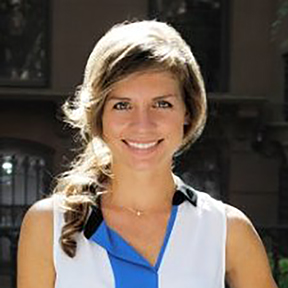In an era where smart cities, intelligent buildings, and responsive environments will be expected to equally adapt to the built environment and to the building occupant, the development of new design tools and energy feedback systems are critical for predicting the aesthetic and performance impacts of our future buildings and cities. How will architects, engineers, and city planners visualize and integrate the quantitative and qualitative effects of dynamic energy flows in accordance with adaptable systems and diverse human preferences? Visualizing energy-based data according to multiple perspectives and performance criteria is essential to understanding its spatiotemporal character, impacts on comfort, and relevance in the design decision-making process.
Assistant Professors Bess Krietemeyer and Amber Bartosh (Syracuse School of Architecture), and interactive artist and software developer Lorne Covington (NOIRFLUX) discussed “Hybrid-Reality for Environmental Design” through the lens of ongoing design research at the SyracuseCoE Interactive Design and Visualization Lab (IDVL) and at the Milton J. Rubenstein Museum of Science and Technology (MoST). They presented collaborative work that explores innovative simulation workflows that merge contemporary techniques for energy modeling with augmented and virtual reality visualization methods in order to facilitate the integration of energy and user feedback in the architectural design process. Following the presentation there was a demonstration of the hybrid reality design research in the Interactive Design and Visualization Lab on the 5th floor of the SyracuseCoE.
Presenters:
 Dr. Bess Krietemeyer
Dr. Bess Krietemeyer
Dr. Bess Krietmeyeris an architectural designer and researcher whose expertise lies at the intersection of advanced building technologies, interactive systems, and building performance simulation. She leads the Interactive Design and Visualization Lab at the Syracuse Center of Excellence, where her research focuses on hybrid-reality simulations for interactive design and energy analysis. She teaches studios and technical courses emphasizing environmental performance within architectural design. Prior to joining Syracuse University, Dr. Krietemeyer conducted interdisciplinary research at Rensselaer Polytechnic Institute’s Center for Architecture Science and Ecology (CASE), where she received her Ph.D. in Architectural Sciences. She has practiced with Lubrano Ciavarra Architects and with CASE and Skidmore, Owings, & Merrill (SOM) on international projects that integrate next-generation building technologies. Her research has been published and presented in several peer-reviewed forums, including installations in New York City and in Troy, as well as SmartGeometry, the International Society for Optics and Photonics, ACADIA, Human Computer Interaction, and most recently featured in the journal Architectural Design. Her book chapter contributions include “Architecture in Formation,” “Inside Smartgeometry: Expanding the Architectural Possibilities of Computational Design,” and “Architecture and Interaction.”
 Amber Bartosh
Amber Bartosh
Amber Bartosh is an architect and interior designer who has designed and managed award-winning projects for competition, bid & design build processes in the United States, China, Kuwait, and the United Arab Emirates. Her interest in sustainability as a standard for all design led to her 2008 accreditation by LEED. She has completed both gold and silver level LEED projects and served as project manager for Emergent Tom Wiscombe LLC, an internationally recognized architectural practice focused on the integration of biology, computation, and contemporary design sensibilities. Following her cum laude double major in Art and Architecture at Rice University she went on to graduate work in the M.Arch2 program at the Southern California Institute of Architecture (SCI-Arc). She completed her work at SCI-Arc with a Master’s in Architecture and the Alpha Rho Chi medal. Amber Bartosh is currently an Assistant Professor for the School of Architecture at Syracuse University where she teaches both foundation studios and representation courses focused on expanding the capacity of digital media in architecture.
 Lorne Covington
Lorne Covington
Lorne Covington, Creative Director and Principal at NOIRFLUX, creates participatory environments that provide immersive exploration, education, advocacy, and improvisational expression. Lorne is fluent with visual and performing art, electronic hardware, embedded systems and all layers of software development, creates immersive responsive environments using cutting-edge sensing and software technologies. Covington’s work focuses on the intangible space between action and response, the moment-to-moment experience of involvement with a complex system that turns the act of viewing into one of exploration, creation and play. Recent projects include “Affectations” at the Kennedy Center, “Dancing Light Theater” at the MOST in Syracuse and the JournoWall Participatory Media Environment at the Newhouse School, where students and faculty can interact with large-scale visual information and sound.
[vc_row][vc_column][vc_video link=”https://www.youtube.com/watch?v=EKFoUlKcyuo” el_width=”60″ align=”center”][/vc_column][/vc_row]
